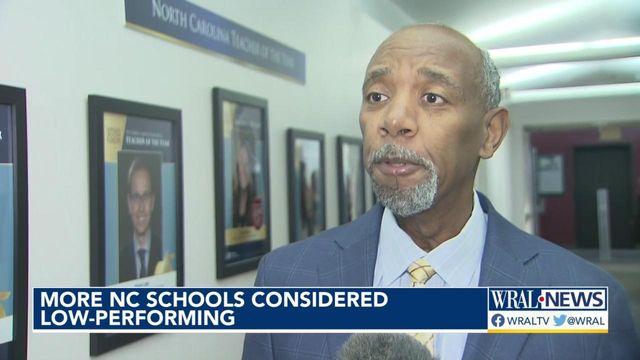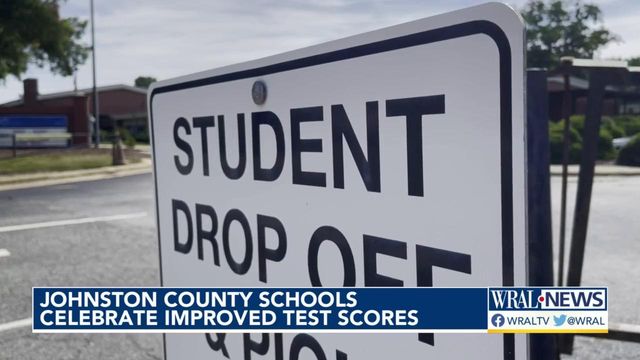1 in 3 NC schools are low-performing, test score data shows
That's up big time, though most schools still managed a letter grade of a C or higher amid concerns about learning loss.
Posted — UpdatedAbout one in three schools will now be on that list, with 864 total designated under new test scores, up from 488 during the 2018-19 school year. That’s the last school year in which schools were added or removed from the list because data collection was suspended during the pandemic.
Placement on the list means those schools will need to draft plans to improve their test results.
Schools that have been on the list for two out of the past three testing years will be considered “recurring” or “continually” low-performing and are eligible to apply for the state’s Restart program. That program gives school charter school-like flexibility to change how they operate for the sake of improved academic performance. That program can also provide a single school with millions more dollars per year.
Students at low-performing schools can also apply to attend one of the state’s six lab schools, though data released Thursday show four of those schools are also on the low-performing list.
Nearly every school system has a low-performing school now — 100 of 115 school districts accounting for 793 schools. That’s out of those districts’ 2,385 schools with calculable results, or about 33.2%. Among charter schools, 67 of 196 with calculable results were low-performing, or about 34.2%.
Before the COVID-19 pandemic, just about 1 in 6 to 1 in 5 NC schools was low-performing in a given year.
At the school district level, 24 school districts are low-performing now, based on 2021-22 test scores, compared to nine based on 2018-19 test scores.
The results come just a day after the state Supreme Court heard oral arguments in the 28-year-old education adequacy lawsuit known as Leandro. In that case, courts have ruled in favor of five lower-income school boards and their students that North Carolina is not providing a constitutionally required “sound basic education.” But a formal plan to resolve that dispute hasn’t been fully funded nor implemented.
Why some parents, teachers and school leaders feel the numbers don’t tell the whole story
Alex Thweatt is glad his daughter is attending Carroll Magnet Middle School.
“She was very excited coming into the year,” Thweatt said.
Carroll Magnet Middle School is one of 38 Wake County public schools designated as low performing.
“We are seeing lower rates of proficiency due to the pandemic,” said Wake County schools Deputy Superintendent Michael Maher.
Former Wake County teacher Emily Harrison taught through the pandemic.
“It’s really hard,” Harrison said. “You can’t expect things to be the same.”
The number of low-performing schools in Wake County grew by eight, about 20% of schools in the district.
“We did the best we could, but there is still going to be gaps,” Harrison said. “I think the growth needs to be the focus point.”
Others agree with Harrison.
“Growth is what is most important,” said Alan Duncan, the vice chairman of the State Board of Education.
In some areas, students are starting to close the learning gap the pandemic created.
“In terms of meeting or exceeding growth, our schools are very close in terms of where they were before,” Duncan said.
In fact, despite the pandemic, some districts have fewer schools on the low-performing list this time, like Cumberland County Schools. Still, Cumberland County Schools Superintendent Marvin Connelly said getting classrooms back to where they were before COVID-19 will take time.
“The pandemic is not over yet and the impact of the pandemic, we will see from years to come,” Connelly said.
How Johnston County Public Schools improved test scores
Johnston County Public Schools is the only school system in North Carolina to see a major drop in the number of underperforming schools in data released Thursday by the North Carolina Department of Public Instruction.
On Thursday, WRAL News spoke with parents and teachers to find out what they did to improve test scores.
For example, Clayton Middle School is one of the schools to improve and fall off the list of low-performing schools. It’s one of 33 schools in the district to exceed expectations for student growth on test scores. Three years ago, only 10 schools made that mark.
Parent Carrie Lee has a son in the third grade at Cooper Academy, where she’s also PTA president.
“When they were faced with adversity, they thought, ‘Well how can we be innovative?’” Lee said. “’How can we think creatively to help students engage and learn?’”
Lee credited the elementary school’s teachers with turning test scores around.
“You can just see that paying off now that we’re back face to face,” Lee said. “You can see the students are empowered, and they want to learn.”
Cooper was one of 14 low-performing schools in Johnston County before the pandemic. That number is down to five: West Clayton Elementary, West Smithfield Elementary, South Smithfield Elementary, Smithfield-Selma High School and Johnston County Virtual Academy.
“We’ll continue to place resources in those classrooms in a way that will help support the work of those teachers, and we anticipate we’ll continue to see the success we saw this year,” said Chief Academic Officer Nicholas King.
King said the school system focused on a district-wide curriculum and improved tracking of testing data that's shared with teachers and students.
“It’s an ongoing process that helps students understand what the goal is that we’re setting for them, and very often having them and their families involved in the process for setting those goals,” King said.
Another thing school system leaders said they’ve done to improve instruction is doing walk-throughs to observe classroom learning. They say they did more than 14,750 walk-throughs in classrooms last year alone.
Johnston County Public Schools rank 41st in the state, moving up from 83rd in 2019.
Edgecombe County Public Schools among state's worst counties for school success
Edgecombe County Public Schools ranks among the five worst counties in the state for school success.
Parents told WRAL News they want something done to address the issue.
The state data released Thursday shows Edgecombe County has 10 low-performing schools, which is 71% of the schools in the district.
Some families said that number is alarming enough that they’re considering their options for their students.
The North Carolina Department of Public Instruction says in 2018-2019, eight out of 14 schools in the Edgecombe County district were low performing.
Parent Keila Archer has a son in elementary school in the district.
“The first place is why?” Archer said. “Where’s it coming from and what is it that we can do to make it better?”
Archer believes part of the problem could be COVID-19's impact on the classroom.
“I do think that was a drastic change for everyone. Like, a drastic change,” Archer said. “From physically being in the school to having to go online.”
The school district agrees.
In a statement, Edgecombe County Public Schools Superintendent Valerie Bridges said the new numbers are reflective of a horrendous pandemic that closed schools and disrupted learning.
“It is not fair nor appropriate to compare data acquired during a pandemic to pre-pandemic data,” Bridges wrote in a news release provided by the district.
Bridges also said the district's grade level proficiency increased from 2020 to 2022.
Archer hopes the return to normalcy in schools could help Edgecombe’s test scores start to climb again, but she's also calling on the district to hold community meetings to give parents more access in their children's education.
“We’re talking about future doctors, teachers, lawyers, so they should get the whole 100%, not just half of it” Archer said.
Related Topics
• Credits
Copyright 2024 by Capitol Broadcasting Company. All rights reserved. This material may not be published, broadcast, rewritten or redistributed.






